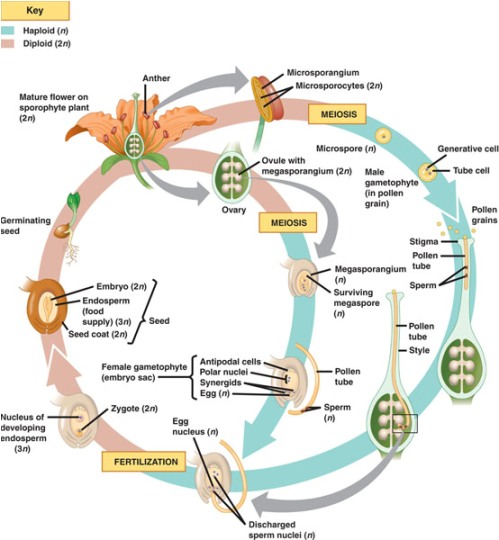Reproduction
 Like other angiosperms, the flowers of the coca bush are used for sexual
reproduction. As stated in the Adaptation's section of this web-page, the
flowers of the coca posses both male and female reproductive parts on the
same flower. The male reproductive part in the coca flower is the stamen,
which is made up of the anther and the filament. The female reproductive
part is the carpel, which is made up of the stigma, style, and the ovary.
The stamen produces microspores that later develop into pollen grains that
contain numerous male gametophytes. Each of these gametophytes poses two
haploid cells, the first is the generative cell that forms two sperm cells,
and the second is tube cell that produces a pollen tube. The carpel produces
megaspores that become female gametophytes, also known as an embryo sac.
Click here to find out
about Morinda citrifolia, a plant that is also classified as a "perferct"
flowers.
Like other angiosperms, the flowers of the coca bush are used for sexual
reproduction. As stated in the Adaptation's section of this web-page, the
flowers of the coca posses both male and female reproductive parts on the
same flower. The male reproductive part in the coca flower is the stamen,
which is made up of the anther and the filament. The female reproductive
part is the carpel, which is made up of the stigma, style, and the ovary.
The stamen produces microspores that later develop into pollen grains that
contain numerous male gametophytes. Each of these gametophytes poses two
haploid cells, the first is the generative cell that forms two sperm cells,
and the second is tube cell that produces a pollen tube. The carpel produces
megaspores that become female gametophytes, also known as an embryo sac.
Click here to find out
about Morinda citrifolia, a plant that is also classified as a "perferct"
flowers.
The life cycle of Erythroxylum coca is similar to the life cycles of other angiosperms. When the pollen from the stamen makes it's way to the stigma of the carpel, and this is when the pollen tube comes in. The pollen tube grows down into the style and after reaching the ovary it discharges two sperm cells into the embryo sac. One of the sperms is used to fertilize the egg while the other is used to form a triploid cell. This is known as double fertilization, a unique feature of angiosperms. After the double fertilization, the ovule matures into a seed with the embryo developing inside along with an endosperm, tissue rich in food reserves for the embryo. The ovary, on the other hand, becomes the fruit, which aids in dispersal of the seeds inside. When the enviornment is favorable, the embryo emerges, using the stored energy from the endosperm. Click here to find out about "Kiss Me Quick", a plant has similar life cycle to E.coca.
Continue to Interactions
Return to Nutrition
Return Home